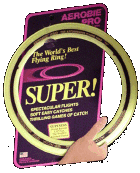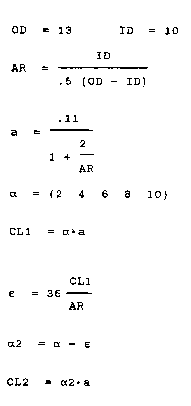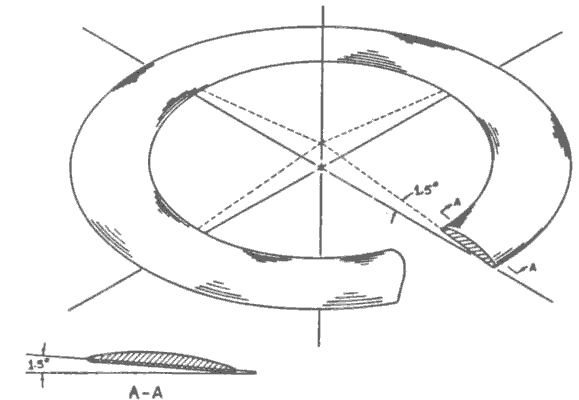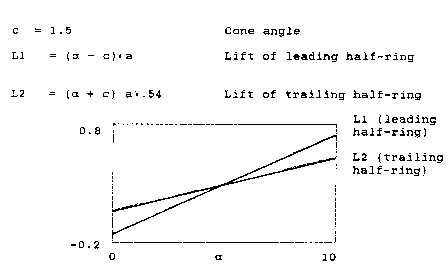THE AEROBIE FLYING RING
Alan Adler - Superflight Inc, Palo Alto, CA
The Aerobie flying ring is the result of eight years of applied research directed at the development of an object which could easily be thrown long distances.
 I focussed on spinning objects because it is easy and natural to swing the arm and launch an object with spin. Spin also imparts valuable stability through gyroscopic inertia. However, spin greatly complicates the aerodynamic design task. I focussed on spinning objects because it is easy and natural to swing the arm and launch an object with spin. Spin also imparts valuable stability through gyroscopic inertia. However, spin greatly complicates the aerodynamic design task.
Early experiments concentrated on thin flying discs, but most airfoils have their center of lift at the quarter chord which is too far forward of the center of gravity (at the half-chord). This produces a pitch-up moment which gyroscopic precession converts to sideways roll.
The most difficult aspect of the design task is that the disc must fly over a wide range of a (angle of attack). It is easy to design an airfoil which has its center of lift at the half-chord at any single a. It is far more difficult to do that over a range of a.
A conventional Frisbee disc partially accomplishes this by employing a thick rim to move the center of lift towards the half-chord. But the price of this rim is a substantial amount of drag. My goal was to reduce drag.
I developed several discs which had thinner rims than a Frisbee, and thus less drag and longer flights. But they were also less stable. After much research and experimentation without further progress, I shifted my design efforts to flying rings.
Flying rings offer more options for controlling the location of the center of lift. In flight a flying ring is like two airfoils in tandem. But the trailing half-ring must fly in the downwash of the leading halfring. Thus a simple symmetrical ring still has its center of lift well forward of the center of gravity. Following is an analysis of a symmetrical ring:
Flying Ring Analysis:
Note that the numerals 1 and 2 in variable names designate the leading and trailing halves of the ring respectively.
 |
|
Dimensions of aerobie (inches)Aspect ratio of each half-ring
taken separately AR = 6.667 Lift slope (CL/Deg) of half-ring a = 0.085 A typical range of
 . Greater . Greater

occurs at the end of the flight. Lift coefficient of leading
half-ring Approximate downwash angle
(degrees) due to the leading
half-ring (at the location of
trailing half-ring) Angle of attack of flow
at trailing half-ring Lift coefficient of trailing
half-ring |

R = Ratio of lift coefficients of half-rings. Note that R is constant at all values of a. The actual ratio may be even lower because the leading half-ring has greater leading edge span than the trailing half-ring.
The above ratio places the center of lift about 1/3 of the diameter behind the leading edge. For straight flight, it must be at the center.
My first attempt at balancing the lift on a spinning ring was to angle the airfoil so the chord line fit the surface of an imaginary shallow cone. I calculated 1.5 degrees as a suitable conical angle for a typical throwing velocity. Of course it was only balanced at one a and thus at one velocity.

Below is an analysis and plot of the lift of the leading and trailing half-rings vs a of the conically shaped ring for
 = . . 10 degrees. = . . 10 degrees.
 Lift of leading and trailing half-rings
Lift of leading and trailing half-rings
vs a for a conically angled ring.
As you can see, this is only balanced at one a (and thus one speed). In fact, I postponed testing this design for more than a year because of this. But when finally tested, it worked surprisingly well. The drag was so low that it sustained flight at near the balance speed for an acceptable fraction of the flight. It set a Guinness world record with a throw of 85? feet. About a million were sold under the trade name "Skyro"
I continued to seek a design which would remain balanced, and thus fly straight, over a range of speeds.
In spinning flight, the flow direction over the ring's section reverses for half of every revolution of spin. It occurred to me that if the ratio of section lift slopes (CL/a) for normal and reversed flow were 1:0.54, downwash effects would be compensated and balance would be achieved. I directed my efforts at the design of such a section.
Initial research was discouraging. The only relevant data was a test on a NACA 0012 which showed no significant difference in lift slope for reversed flow.

One of the early sections tried was a reflexed airfoil. I theorized that in reversed flow the reflex would cause early separation and reduce CL/a. But this section was just as speed sensitive as the conical design.

I tried several other (unsuccessful) designs before returning to the reflexed concept. My next section had a filled-in area under the reflex to establish the Kutta condition at a level lower than the leading edge stagnation point and thus produce adequate lift for normal flow. It also had a much more severe reflex, more like a spoiler.

Flight tests quickly showed that this was the design I had been seeking. The ring was exceptionally stable over a wide range of speeds.
The last step was to optimize the section. I experimented with design variations in the section profile, the spoiler, and the flap. About a dozen rings were tested and the one exhibiting the best combination of stability and low drag was selected for production. The selected section even remained balanced in stall.
Although my intent with this section design was to reduce the lift slope for reversed flow, it is quite likely that the thick trailing edge also increases the lift slope for normal flow. The important thing is that the ratio of the lift slopes (for normal and reversed flow) be great enough to compensate for downwash and provide balanced flight.
While the "spoiler" slightly increases the section drag, its contribution to stability is so beneficial that overall performance is much better than the earlier conical design. An Aerobie has been thrown 1,257 feet -- a new Guinness record.
|